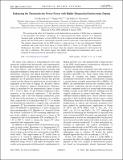| dc.contributor.author | Lee, Joo-Hyoung | |
| dc.contributor.author | Wu, Junqiao | |
| dc.contributor.author | Grossman, Jeffrey C. | |
| dc.date.accessioned | 2010-07-15T18:44:33Z | |
| dc.date.available | 2010-07-15T18:44:33Z | |
| dc.date.issued | 2010-01 | |
| dc.date.submitted | 2009-07 | |
| dc.identifier.issn | 0031-9007 | |
| dc.identifier.uri | http://hdl.handle.net/1721.1/56609 | |
| dc.description.abstract | We investigate the effect of O impurities on the thermoelectric properties of ZnSe from a combination
of first-principles and analytic calculations. It is demonstrated that dilute amounts of O impurities
introduce peaks in the density of states (DOS) above the conduction band minimum, and that the charge
density near the DOS peaks is substantially attracted toward O atoms due to their high electronegativity.
The impurity-induced peaks in the DOS result in a sharp increase of the room-temperature Seebeck
coefficient and power factor from those of O-free ZnSe by a factor of 30 and 180, respectively.
Furthermore, this effect is found to be absent when the impurity electronegativity well matches the
host that it substitutes. The results suggest that highly electronegativity-mismatched alloys can be
designed for high performance thermoelectric applications. | en_US |
| dc.description.sponsorship | National Science Foundation | en_US |
| dc.description.sponsorship | Network for Computational Nanotechnology (Grant No. EEC-0634750) | en_US |
| dc.description.sponsorship | Teragrid | en_US |
| dc.description.sponsorship | National Energy Research Scientific Computing Center | en_US |
| dc.description.sponsorship | Lawrence Berkeley National Laboratory (Department of Energy Contract No. DE-AC02- 05CH1123) | en_US |
| dc.language.iso | en_US | |
| dc.publisher | American Physical Society | en_US |
| dc.relation.isversionof | http://dx.doi.org/10.1103/PhysRevLett.104.016602 | en_US |
| dc.rights | Article is made available in accordance with the publisher's policy and may be subject to US copyright law. Please refer to the publisher's site for terms of use. | en_US |
| dc.source | APS | en_US |
| dc.title | Enhancing the Thermoelectric Power Factor with Highly Mismatched Isoelectronic Doping | en_US |
| dc.type | Article | en_US |
| dc.identifier.citation | Lee, Joo-Hyoung, Junqiao Wu, and Jeffrey C. Grossman. “Enhancing the Thermoelectric Power Factor with Highly Mismatched Isoelectronic Doping.” Physical Review Letters 104.1 (2010): 016602. © 2010 American Physical Society. | en_US |
| dc.contributor.department | Massachusetts Institute of Technology. Department of Materials Science and Engineering | en_US |
| dc.contributor.approver | Grossman, Jeffrey C. | |
| dc.contributor.mitauthor | Grossman, Jeffrey C. | |
| dc.contributor.mitauthor | Lee, Joo-Hyoung | |
| dc.relation.journal | Physical Review Letters | en_US |
| dc.eprint.version | Final published version | en_US |
| dc.type.uri | http://purl.org/eprint/type/JournalArticle | en_US |
| eprint.status | http://purl.org/eprint/status/PeerReviewed | en_US |
| dspace.orderedauthors | Lee, Joo-Hyoung; Wu, Junqiao; Grossman, Jeffrey C. | en |
| dc.identifier.orcid | https://orcid.org/0000-0003-1281-2359 | |
| mit.license | PUBLISHER_POLICY | en_US |
| mit.metadata.status | Complete | |
